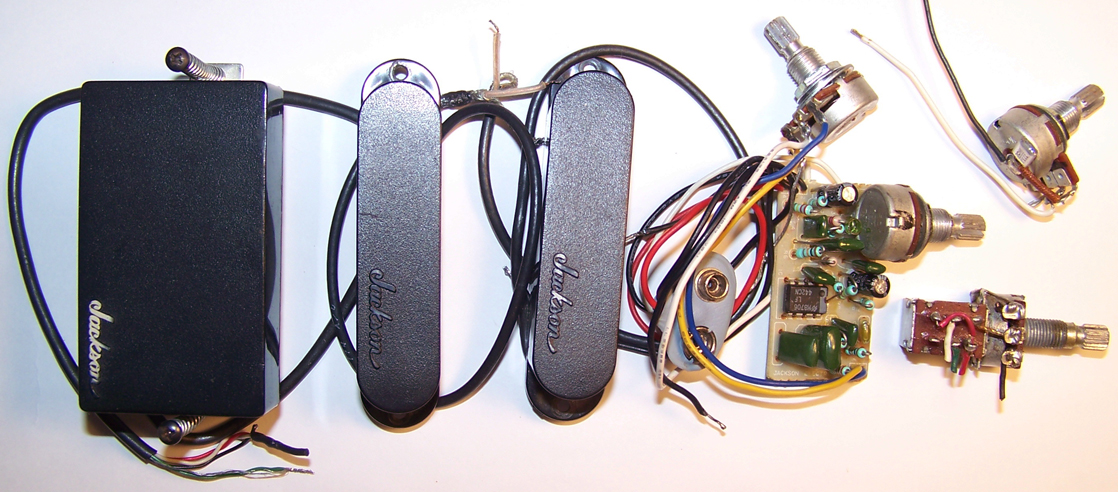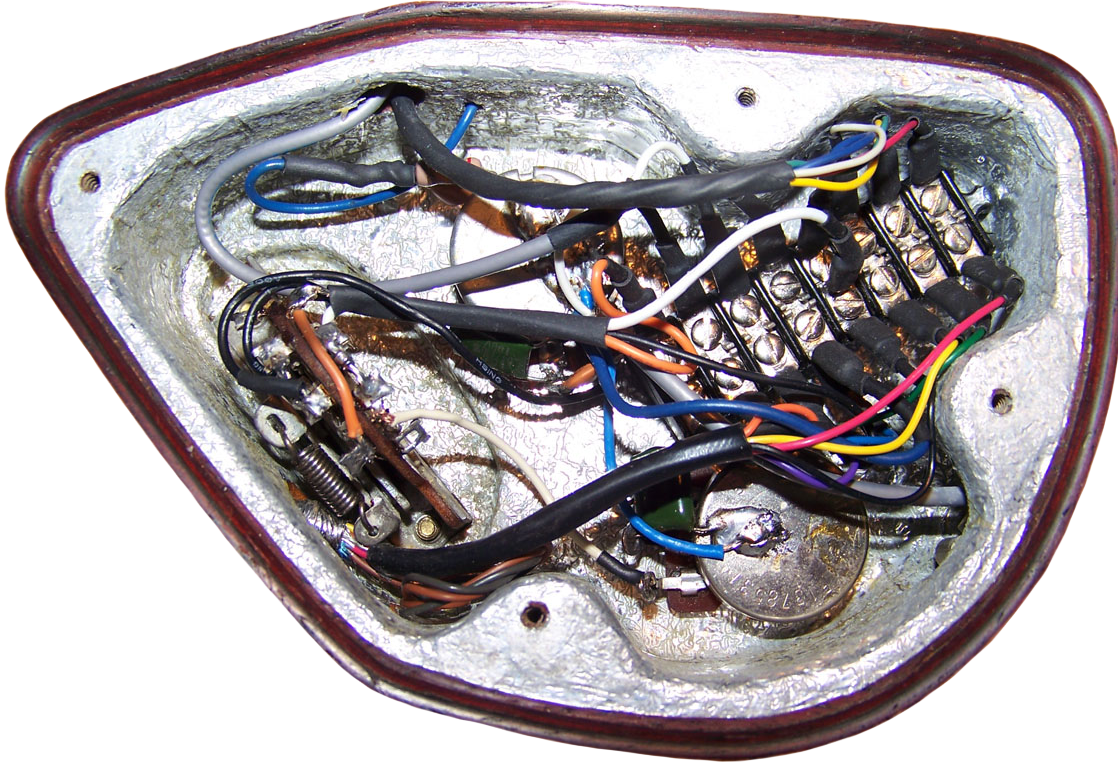
 Introduction:
Introduction:
The electronics of your instrument are a big part of how it sounds, and more important than you may think. With electric solid body instruments it is a controversial subject to say the least, because there are two main camps when it comes to that: One believes that the wood and construction of the instrument plays an important role, and the other believes that it plays little to none at all, but belief is not always based on facts, and we will get into those here.
Many players have toyed with the idea of having different sounding pickups and switching capabilities, or want a more or less balanced sound than what they have, and there are a great many things that can be done on board (in the instrument) to get what you want, but also in your other equipment. If your Paul Reed Smith guitar sounds like crap, than maybe you should ditch the $15 amplifier you got from Radioshack first, and spring for a Mesa Boogie, before you spend $200 on different pickups, as they wont make any difference.
In the following paragraphs I will try to shed some light on the subject of what the electronic possibilities are and how they effect the sound of your instrument. Since there are so many possibilities, you should keep in mind that it can become daunting and overwhelming if you want to get into all the technical details. Therefore the first topic is the one you should read above all else, after that it may be easier to narrow your choices down, to something that fits you and your playing style, but is also manageable. All the bells and whistles sounds great until you get overwhelmed with to many controls to use in practice. In the end it comes down to your ears in finding your sound.
 What are your needs?
What are your needs?
You, and you only, can hear with your ears, and no matter what anyone else says about what their recommendations for pickups and how to wire them are, your ears are what you have to go by. I can give you pointers on what will happen if you change the way the pickups in your guitar are wired, change potentiometer values, replace tone filtering capacitors and resistors and what not. There are hundreds of descriptions of what one or another pickup, wiring scheme... sound like, all over the internet, and someone describing the exact sound you already have, may make it sound like they are describing something completely different!
There are a great many pickups out there and I have known a few players who change the pickups in their guitar more often than socks, in the endless search for the ultimate sound, only to never find it. Lets face it, you may never sound like "that guy" even if he handed you his guitar, amp and everything else he uses, because you do not play like him in the first place. How you play can make a lot of difference in your sound too, that being said you are still facing the many options of electronics in guitars and other instruments of the lute family.
In all reality it is much easier to start with what you already have, and together we can figure out where to go from there. Now read on to get a better idea of what your options are, keeping in mind that it is general information for the most part, and when the time comes we can actually play with your electronics and let your ears do the judging, prior to blowing your money on stuff you may not need.

 Electronics in acoustic instruments:
Electronics in acoustic instruments:
Acoustic instruments are great by themselves, until you are in front of a large audience and need amplification. A microphone on a stand pointed at your guitar will do, unless you cant stop grooving and move to much to have that work well enough. Thanks to modern electronics many acoustic instruments come with built in electronics, and those that don't, can have them added.
The most prevalent problem with amplified acoustic instruments is unwanted feedback. In order to deal with it, there are a few physical devices that can help such as dampeners and sound hole covers. Electronically, the most significant remedy is a preamp which contrary to its name is not used to amplify the signal, but rather to balance it out. Most modern preamp's have an equalizer built in, that allows one to cut the offending frequencies, and also a gain control that is somewhat different than a volume control.
Gain is used to control the electrical power of the signal to the soundboard or amplifier. As you raise the gain on an amplifier, the sound can get distorted as its power goes beyond what the amplifying circuit can reproduce cleanly, essentially over driving it. On an acoustic instrument it is used to cut down the signal power, so that it does not add to the resonance of the instrument.
Acoustic instrument pickups come in a few different flavors, that have differing characteristics. I will not address the removable kind here, as you probably don't need me to install one. Instead I will focus on the ones that need some work to be installed, and are more permanent.
Most rare these days are actual microphones built into the instrument that pick up sound via air movement. Then there are piezoelectric contact pickups, that pickup sound from whatever surface they are mounted to, where the sound can vary greatly based on where they reside. Most common are the under saddle pickups which are also piezoelectric, but either sandwiched between the saddle and bridge, or molded into the saddle. They get most of their sound directly from the vibrating strings, and the actual acoustic sound of the guitar is not what you will hear.
The best preamp systems can have more than one pickup like one under saddle, and one or more contact pickups and/or a microphone, that can be controlled separately, and allowing for a wider range of sound. They are normally not standard equipment though, but can be retrofitted to most instruments, some without altering the instrument greatly, and others with some cutting and/or drilling involved.
When it comes to electrical systems for acoustics the phrase "You get what you pay for" is a warning to be taken seriously, as the difference in sound and control can easily be heard throughout the range of available products. There are also several companies making these in fierce competition, so it is not easy for me to recommend anything specific now, as the products change so often, that I can not keep up with it. If you would like a system installed into your acoustic instrument, than we can look for something suitable to your needs when the time comes, and check out the latest and greatest.
 The truth about solid body sound:
The truth about solid body sound:
Solid body guitars do not resonate much at all compared to acoustics, and the choice of woods and construction methods have much less to do with the sound. I know, you were led to believe that "Exotic woods" sound much better than a toilet seat made of press board and covered in vinyl, but it is just not true! It does make for good marketing though when counting on a myth that won't die. Exotic woods are more rare and exclusive, have natural beauty and are made by mother earth, so even I prefer them over particle board... On the other hand, the materials and construction methods do influence sustain or decay and can shape the tone a little, but not entirely.
One myth is that the woods used have absolutely nothing to do with the sound, and it's all in the bridge, pickups and electronics. Well, that is not true either, because the strings do resonate, and through kinetic energy, the little resonance that the wood parts do provide, is transferred back to the strings, and the strings will transfer that to the pickups.
But in the end, the electronics are a big part of the sound of your solid body instrument, and also the place where the most dramatic changes can be made. Some minor changes to tone can be made by changing potentiometer values of both the volume and tone controls. More tone changes can be made by changing or adding other components in the tone circuit. The most dramatic changes in both tone and volume can be achieved via the pickups used and how they are wired and switched, and with preamps.